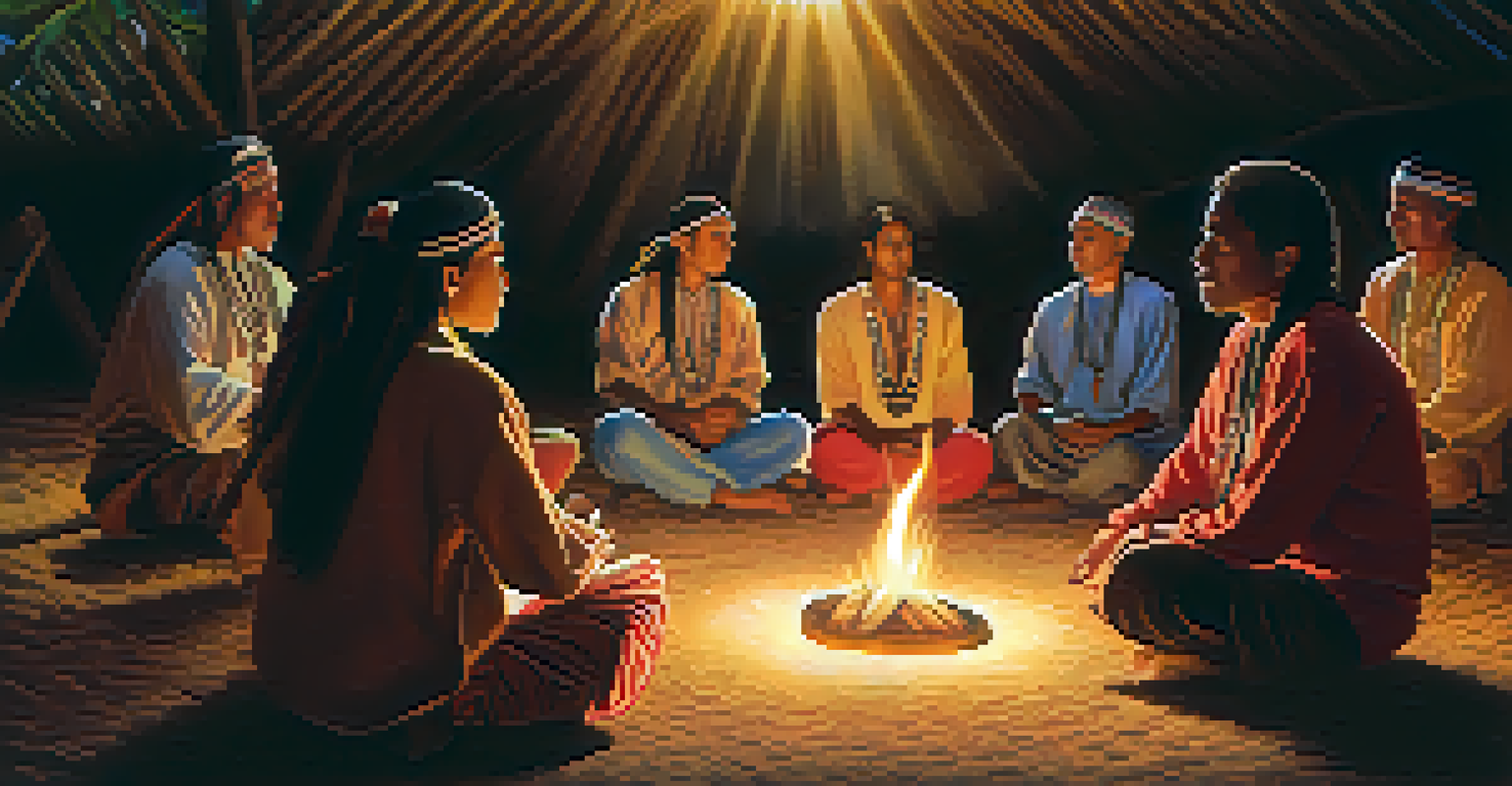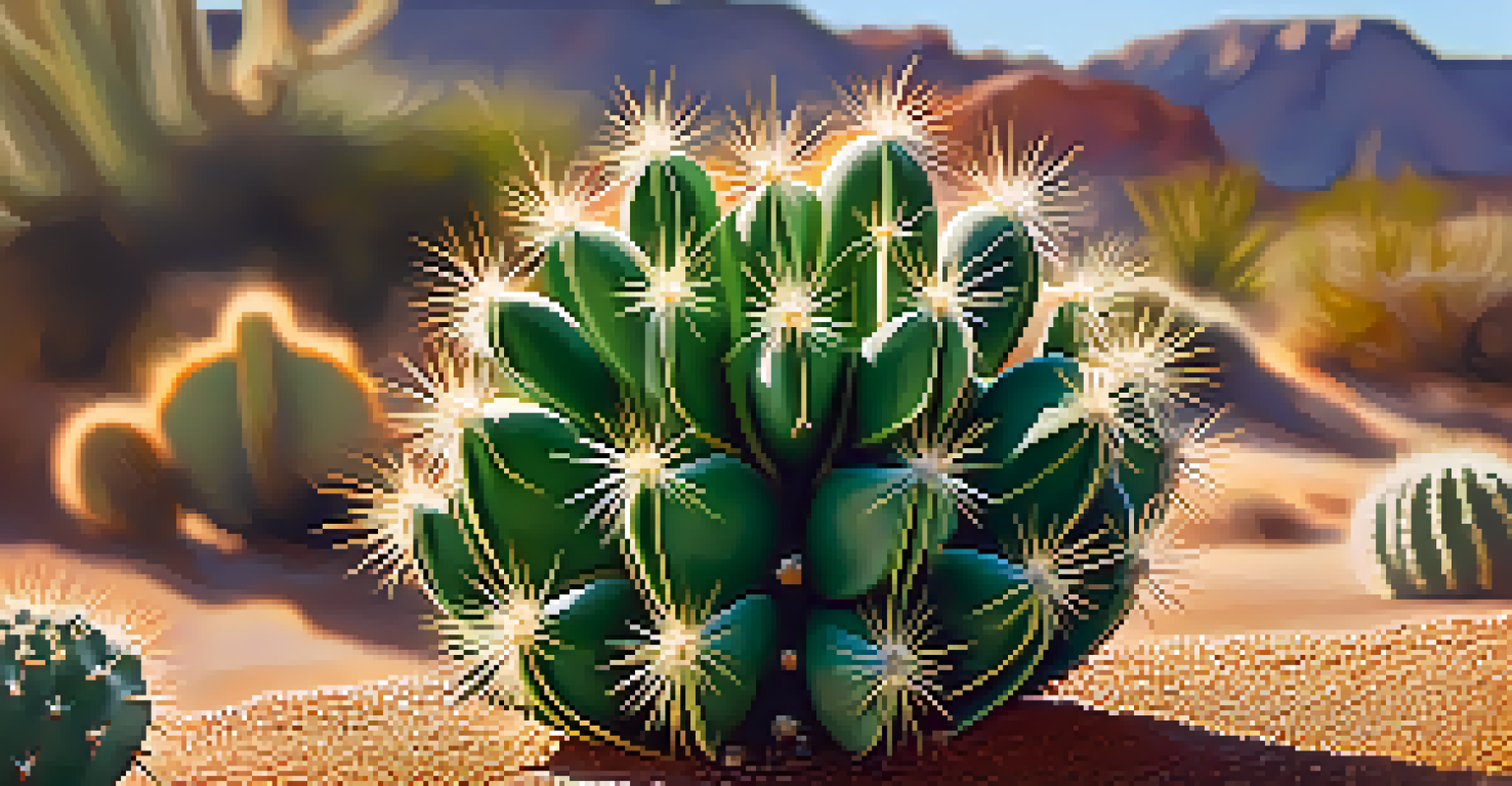The Use of Peyote in Indigenous Healing and Spirituality

Understanding Peyote: A Brief Overview
Peyote, a small cactus native to the southwestern United States and Mexico, has been used for centuries by Indigenous peoples for its psychoactive properties. This cactus contains mescaline, a compound that induces altered states of consciousness, making it a vital part of various spiritual practices. Its use transcends mere recreation; it serves as a gateway to deeper understanding and connection with the universe.
Psychoactive plants like peyote can open the door to an experience of the sacred, a journey that can lead to profound healing and spiritual awakening.
In many Indigenous cultures, peyote is not just a plant but a sacred entity that holds significant spiritual meaning. It’s often associated with visions, healing, and communion with the divine. The cultural heritage surrounding peyote reflects a profound respect for nature and an understanding of the interconnectedness of all life.
Understanding peyote begins with recognizing its historical significance among tribes such as the Huichol and the Native American Church. These communities have woven the use of peyote into their cultural fabric, creating rituals and traditions that honor its role in healing and spirituality.
Cultural Significance of Peyote in Indigenous Traditions
For many Indigenous communities, peyote is much more than a psychoactive substance; it is a cultural cornerstone. The rituals surrounding its use are deeply embedded in their spiritual practices and often involve communal gatherings, songs, and prayers. These ceremonies are designed to foster a sense of unity and collective healing among participants.

The spiritual journey facilitated by peyote often leads individuals to profound insights about themselves and their place in the world. This transformative experience is not taken lightly and is approached with reverence and preparation. Participants typically engage in fasting and cleansing rituals to ensure they are spiritually and physically ready for the experience.
Peyote's Cultural Importance
Peyote is a sacred plant in Indigenous cultures, integral to spiritual practices and community healing rituals.
Moreover, the cultural narratives surrounding peyote emphasize its role in connecting individuals to their ancestors and the earth. This relationship illustrates a broader worldview that values harmony, respect, and reciprocity with nature, which is central to many Indigenous philosophies.
The Healing Properties of Peyote in Indigenous Medicine
In Indigenous healing practices, peyote is often used as a medicinal tool for both physical and mental ailments. Traditional healers may incorporate peyote into ceremonies aimed at treating various conditions, ranging from chronic pain to emotional distress. The plant's psychoactive effects can lead to a sense of relief and clarity for those struggling with psychological issues.
The use of peyote for spiritual and medicinal purposes is a fundamental aspect of Indigenous cultures, reflecting a deep understanding of the relationship between humans and nature.
Healing ceremonies can last for hours and are conducted in a safe, supportive environment, allowing individuals to explore their inner thoughts and feelings. The experience often results in emotional release and a renewed sense of purpose. This therapeutic aspect of peyote is recognized not only within Indigenous cultures but increasingly by modern wellness practitioners.
It's essential to note that the healing properties attributed to peyote are intertwined with cultural beliefs and practices. The effectiveness of peyote as a healing agent is often enhanced by the community support and spiritual framework surrounding its use, showcasing the holistic nature of Indigenous medicine.
Peyote and Spiritual Awakening: A Path to Enlightenment
Many individuals who partake in peyote ceremonies report experiences of spiritual awakening and enlightenment. These sessions often provide insights that can lead to significant life changes and a deeper understanding of one's purpose. The altered states of consciousness induced by peyote allow participants to confront personal challenges and gain clarity on their life paths.
The visionary experiences associated with peyote are often described as profound and life-altering, offering perspectives that extend beyond everyday reality. Participants may encounter symbols or messages that resonate deeply within them, leading to transformative realizations. This journey is often seen as a sacred exploration of the self and the universe.
Healing Properties of Peyote
Indigenous healing practices utilize peyote for its psychoactive effects, offering relief for both physical and mental ailments.
For many, the spiritual aspect of peyote is as important as its medicinal properties. The blend of healing and spirituality creates a unique experience that fosters personal growth and community bonding, emphasizing the interconnected nature of life and the spirit.
The Role of Rituals in Peyote Ceremonies
Rituals play a crucial role in the effective use of peyote in Indigenous practices. These rituals create a structured environment that fosters safety and respect during the peyote experience. They often include elements such as prayer, singing, and drumming, which help to set the tone and elevate the spiritual atmosphere of the gathering.
Each ritual is carefully designed to guide participants through the experience, ensuring that they feel supported and connected to the group. The presence of an experienced leader or shaman is often vital, as they provide guidance and assistance throughout the ceremony. This leadership helps to ground participants and facilitate deeper engagement with their experiences.
Additionally, rituals serve to reinforce the cultural significance of peyote, reminding participants of their shared heritage and the values that underpin their practices. Engaging in these traditions fosters a sense of belonging and continuity with past generations, linking the present to the rich tapestry of Indigenous history.
Challenges Facing Indigenous Peyote Practices Today
Despite its deep-rooted significance, the use of peyote faces numerous challenges today. Legal restrictions and societal misconceptions about its use can hinder Indigenous communities from practicing their traditions freely. Many tribes are fighting to protect their rights to use peyote in traditional ceremonies, emphasizing its importance to their cultural identity.
Furthermore, the environmental impact of overharvesting peyote poses a significant threat to its availability for Indigenous communities. As demand grows, the sustainability of peyote populations becomes increasingly precarious, raising concerns about the future of this sacred plant. Efforts are being made to raise awareness about its conservation and promote sustainable practices.
Challenges to Peyote Practices
Indigenous communities face legal restrictions and environmental threats that jeopardize the sustainable use of peyote in their traditions.
There is also a growing interest in peyote from non-Indigenous individuals, which complicates its use. This interest often leads to cultural appropriation, where the significance of the rituals is overlooked or misunderstood. Advocating for respect and understanding of Indigenous practices is crucial in preserving the integrity of peyote ceremonies.
The Future of Peyote in Indigenous Healing and Spirituality
Looking ahead, the future of peyote in Indigenous healing and spirituality hinges on the balance between preservation and adaptation. Indigenous communities are actively working to protect their traditions while also addressing contemporary challenges. This includes educating others about the significance of peyote and advocating for its legal protection.
As the dialogue around plant medicine continues to grow, there is potential for greater understanding and respect for Indigenous practices. Collaborations between Indigenous healers and modern wellness practitioners could lead to innovative approaches that honor traditional knowledge while addressing modern health challenges.

Ultimately, the future of peyote lies in the hands of those who recognize its sacredness and the wisdom it offers. By fostering respect for Indigenous traditions and supporting their rights, we can help ensure that peyote continues to play a vital role in healing and spirituality for generations to come.